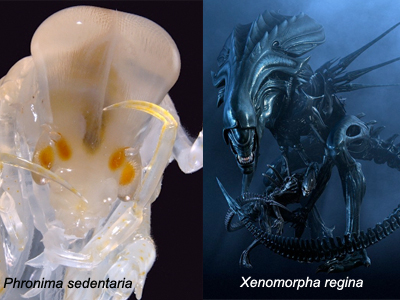 |
Deep in the ocean where only submarines and unmanned deep dive vehicles can go, lives the species that inspired the Alien movies, and rightfully so it did.
The Phronima is a small, translucent deep sea hyperiid, closely related to amphipods (crustaceans). To put it in relative perspective, it resembles a common shrimp — with a similar head, eyes, jaws and clawed arms, but don’t count it out just yet. The Phronima is truly alien in nature and instinct.
Deep past 1,000 feet in the ocean (where the sun’s rays no longer reach), thrives the Phromina, an innovative creature that hunts for pray in hopes it can use it as a host. Just like the Xenomorphs in the movie Alien, the Phromina’s biological life cycle directly relates to violently implanting itself and its offspring inside living hosts, though whether they erupt from their chests in the same manor is something unseen.
What we do know is, when pray is found, she and her newly developed pink offspring live in the belly of the host, including creatures like jelly. With Phrominas’ good sight and impressive claws, this 2.5 centimetres (0.98 in) long mystery is a deadly predator to creatures even double its size.
These ‘natural aliens’ live in an impressive world where life is the closest it can be to being utterly translucent. And where any light created is coming (only) from other creatures — closely resembling a light show, fire works and even infrared light.
Though there is much speculation whether the Phronima is actually what inspired the Xenomorphs in Alien movies, the truth is obvious in the Phronimas’ ruthless means to survive by hosting itself and young in other creatures, though the likeness is obviously derived from the inspiring painting of Giger, Necronom IV.
Check here to see a YouTube click of a Phronima, or for a more aweinspiring look at the Phronima and other amazing deep sea creatures, watch BBC The Planet Series “The Deep.”
Nature is truly amazing, even the creatures we may never get to see in person.
Did Phronima inspire the design of the Alien Queen?
Published December 10, 2009 Amphipods 8 CommentsThe story seems to originate from David Attenborough’s narration in the “Blue Planet” documentary (Skip to 3:25 in this video for the scene in question). Some people around the web rebut this, stating that the original alien design was based on a painting by artist H. R. Giger. This seems to be the case as far as the original “soldier” alien morph seen in “Alien” (1979) is concerned. It is much more likely that Phronima actually influenced the design of the queen alien morph, seen in “Aliens” (1986).
I’ve tried to contact someone at the special effects company, Stan Winston Studios, but they seem to be hard to get a hold of if you are not the producer of a multi-hundred-million dollar blockbuster. Instead, lets talk a little about Phronima, which is an awesome animal regardless of whether or not it was the inspiration for the alien queen.
Phronima is a planktonic amphipod crustacean that lives in the pelagic zone (existing in the water column, not on the bottom) of the deep sea. There are two very distinct characteristics about these animals that may have influenced the design of the alien queen. I will talk about each of them in some detail.
Eyes
The most immediately recognizable feature of Phronima is the broad crest atop its head. This morphological feature is actually one set of the animal’s eyes, and represents a classic deep sea visual adaptation. These tubular eyes point upwards, towards the limited down-welling irradiance. The huge facets of these eyes collect whatever light makes it down to that depth, silhouetting potential prey above in the water column. The light travels down long wave-guides to the retina which is near the bottom of the head (the retina appears black in the photos). This tubular eye structure maximizes photon capture and is seen in a variety of other deep-sea crustaceans, squid, and fish.
The second set of eyes protrude from the side of Phronima’s head, and are more akin to other crustacean eyes. They probably look for bioluminescence to the sides and below the animal. It is thought that these eyes are used to spot the animals that Phronima likes to make their homes and nurseries out of…
Necro-parasitism
A gristly feature of Phronima that is reflected in the alien queen, is what I would call necro-parasitism. Females hunt down free-floating tunicates. They devour all the living tissue from the unlucky animal, leaving a barrel shaped house to live inside and drive around the deep sea in search of more prey (see below). Eventually, the female Phronima lays its eggs along the inside walls of the tunicate barrel, where the offspring grow and hatch.
It is possible that the alien queen was derived completely independently of Phronima, however I find the comparison shot below, taken from a 1981 paper and from “Aliens” respectively, to be strongly suggestive of a connection.

References:



No comments:
Post a Comment